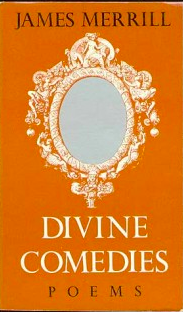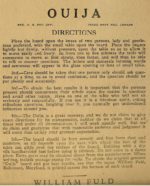By Jake Cordero
Consider this: by the late 1960s, sales of the Ouija board rivaled that of America’s best-selling board game, Monopoly. In small towns and large, from Los Angeles to New York, the famous wooden plank and planchette seemingly was everywhere, delivering titillating, subversive entertainment for teen-agers and grad students, housewives and poets. But Ouija was no ordinary toy. Although manufactured and mass-produced by the very staid Parker Brothers corporation, Ouija was steeped in spiritualist traditions dating back at least a century and was associated with esoteric religions, paranormal exploration, art and literature.
Just below we provide a quick history of the Ouija Board, a brief recitation of some of its cultural impact, and some useful how-to instructions. If you want to get right to that last part then scroll down to the bottom, right to the “HOW TO” subtitle.
HISTORY
According to Mitch Horowitz, author of the critically acclaimed Occult America, the origins of the device known today as the Ouija Board can be traced back to the late 19th Century — although not reliably further back than that. Horowitz cites a March 28, 1886 article appearing in the Sunday supplement of the New York Daily Tribune entitled “A Mysterious Talking Board and Table over Which Northern Ohio is Agitated.” The article included an illustration and description of an early talking board very similar to today’s version.
Six years after the appearance of that article a patent for a “Ouija or Egyptian luck-board” was filed by Baltimore attorney Elijah H. Bond, who in turn assigned the rights to Charles W. Kennard and William H.A. Maupin. This early talking board (the patent was filed on May 28, 1898) was the first with the Ouija name. Like the previous version (and most subsequent ones) this board was rectangular, had two rows of letters across the top, numbers spaced along the bottom and the mysterious sun and moon symbols labeled respectively YES and NO. The words GOOD BYE also was written across the bottom, all in capital letters.
 The Kennard Novelty Company manufactured the board for several years, although founder Charles Kennard eventually left the firm after a series of financial disputes with his partner. The firm’s management fell soon afterwards to its young varnisher, a man named William Fuld. Ambitious, Fuld, at age 19, already had filed for a separate patent for an improved planchette, and later would consolidate control over manufacturing and marketing. It was famously Fuld’s name that would be affixed to hundreds of thousands of Ouija boards created both by his own company and those later by Parker Brothers.
The Kennard Novelty Company manufactured the board for several years, although founder Charles Kennard eventually left the firm after a series of financial disputes with his partner. The firm’s management fell soon afterwards to its young varnisher, a man named William Fuld. Ambitious, Fuld, at age 19, already had filed for a separate patent for an improved planchette, and later would consolidate control over manufacturing and marketing. It was famously Fuld’s name that would be affixed to hundreds of thousands of Ouija boards created both by his own company and those later by Parker Brothers.
And it is Parker Brothers that launched this spiritualist novelty into the mainstream. The company purchased the rights in 1966, reportedly sold more than two million units in 1967 (topping its Monopoly sales that year) and then more than 10 million in the decades since. Although the popularity of the “Ouija Talking Board Game” has ebbed and flowed over the years, some version of it has continued to be produced in one way or the other for the last century.
CULTURAL IMPACT
The board has influenced religious feeling, but also has been the object of fearful warnings among some evangelical Christians. (Just check out some of the online product reviews for a sample.) The board helped inspire Vietnam’s Cao Đài religion, which is based in part on Ouija-inspired prophesies. There’s also plenty of important spiritualist writings — the New Age “Seth Material” comes to mind — originating from Ouija communication.
The Ouija board also has had an impact on the literary world, especially in the United States. One colorful example comes to us with the story of Illinois resident Pearl Lenore Curran who in 1913 claimed to have made Ouija contact with a 17th-century spinster named Patience Worth. Curran, writing in the voice of this 17th Century woman, created an astonishing number of novels, plays and poems. The feat was all the more amazing given that Ms. Lenore was not highly educated and never even finished high school.

Four years after Curran supposedly made contact with Patience Worth, Missouri resident Emily Grant Hutchings released her 230-page novel “Jap Herron,” which she said had been dictated to her by the spirit of Mark Twain. Jap Herron was sold by American book sellers and created a brief literary stir before being removed from shelves after the Samuel Clemens’ estate rose objections. Famous poets Sylvia Plath and Ted Hughes also were said to have created works via Ouija communication.
And then finally we come to American poet James Merrill. His 1976 epic poem, The Book Of Ephraim, merits our special attention because this work, more than any other, constitutes a very significant Ouija-inspired contribution to American arts and letters. Beautifully written, The Book Of Ephraim recounts the experience of Merrill and his partner with the Ouija and clearly was inspired by messages received through the device. The Book of Ephraim comprised the major part of the poet’s seventh anthology, Divine Comedies, which won the Pulitzer Prize in 1977.
HOW TO
Ouija Board sessions work best with two or three participants, and sessions with four also can be successful. We’ve seen Ouija sittings with just a single participant or as many as six — but I don’t recommend either. As with other forms of spiritualist communication, meditation is important. Sit quietly before you begin, spending as much time as is necessary to relax and clear your mind. We typically proceed in a darkened room, lit either by a solitary red light, a night light or a candle. Burning frankincense or sage adds to the mood, as does soothing, non-distracting music. Wordless instrumental or classical music works best.

Ouija boards typically are placed on table tops, with the wooden planchette placed in the center. If you’re using the board with only one other sitter, then you may want to remove the table altogether and sit face-to-face with your partner, your knees almost touching, and place the board on top of you and your partner’s legs. Either way, the finger tips of both hands of all sitters should be placed lightly on the edge of the planchette. Keep your elbows slightly up, your wrists slightly bent, and your forearms more or less parallel with the floor.
If you want to focus your Ouija session on some specific person, recently deceased or from the long-ago past, then you may want to have a photograph of that person nearby. Otherwise just keep an image of that person in your mind’s eye. (I would say as an aside that I typically forego any attempt to make contact with a specific individual. I feel one can never be too sure as to provenance of the Ouija board message, and so it’s better first to seek contact with any spirit and then to seek identifying information as you go along.)
After a few moments, call out “is there anyone there?” or “can you show us a sign?” In short order the planchette may move, and very possibly will move to the word “YES.” Remain patient, wait for movement, take deep breaths, relax and watch for messages. The planchette will often move to YES or NO or spell out letters, and then return to the center of the board between each signal. The appropriate sign can be gleaned by examining the letter, word or number beneath the glass window in the center of the planchette, or by examining the letter, word or number at the end of the pointer. Some sitters (not myself, however) prefer covering the window with a small bit of tape, and then accept only messages indicated by the planchette’s pointed end.
We have found that even if the planchette doesn’t move immediately, it will eventually move if one sits in a quiet meditative state and remains patient. But if the planchette doesn’t move after a prolonged period then the sitters should consider moving it around the board on their own (keeping their arms in the proper position) and then returning it back to the center. Do this a few times. This activity should relax the muscles of all those gathered and often will facilitate communication.
Then, just let the planchette move on its own accord. Allow it to write out numbers or letters. Keep in mind that the letters thus delivered may be initials, an acronym, or may symbolically represent other bits of information, such as dates or addresses. Even if jumbled, the letters doubtlessly carry some important meaning. If you think you suspect that meaning — for instance, if you believe you recognize part of a name — then call it out. The planchette may move to the word “YES” if you have guessed correctly.
This process can take an hour or hours. We always recommend keeping a record of your experiments so have a recording device nearby. Call out the letters and numbers as indicated by the planchette and then afterwards transcribe the recording. In this way you can take all the time you need to make sense of the message, gleaning names and history where appropriate and — you never know — stringing together words for America’s next Pulitzer Prize winner.
Good luck.

0 comments on “Ouija: Millions Sold, But No Ordinary Toy” Add yours →